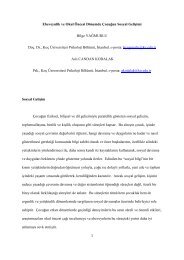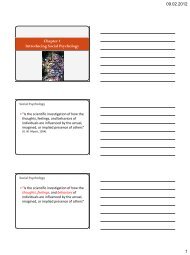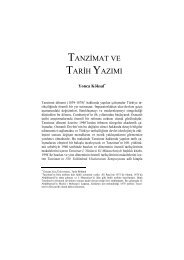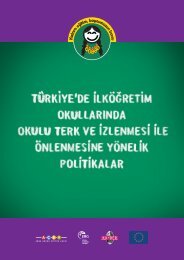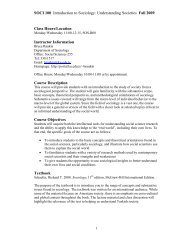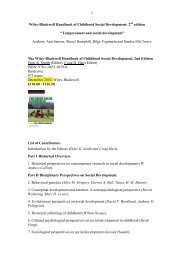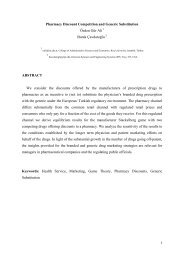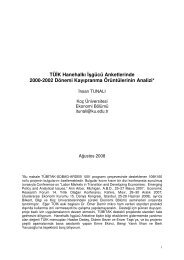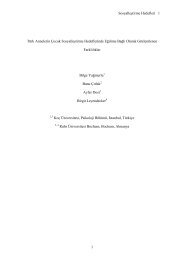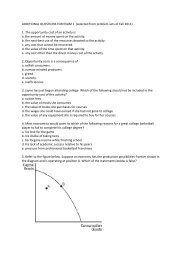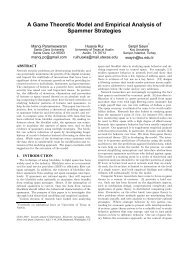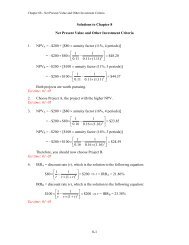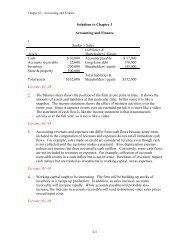The Role of Emotion Regulation in the Treatment of Child Anxiety ...
The Role of Emotion Regulation in the Treatment of Child Anxiety ...
The Role of Emotion Regulation in the Treatment of Child Anxiety ...
Create successful ePaper yourself
Turn your PDF publications into a flip-book with our unique Google optimized e-Paper software.
288 Cl<strong>in</strong> <strong>Child</strong> Fam Psychol Rev (2007) 10:275–293<br />
mo<strong>the</strong>r might help her child re<strong>in</strong>terpret a failed attempt to<br />
perform <strong>in</strong> public by say<strong>in</strong>g that <strong>the</strong> act was too difficult. In<br />
exposure <strong>the</strong>rapy such re<strong>in</strong>terpretation <strong>of</strong> events is sometimes<br />
<strong>of</strong>fered by <strong>the</strong> <strong>the</strong>rapist who po<strong>in</strong>ts out to a socially<br />
anxious child that a child <strong>in</strong> <strong>the</strong> front row yawned because<br />
he was tired and not because her presentation was bor<strong>in</strong>g.<br />
In a similar fashion, children can be taught how to <strong>in</strong>terpret<br />
physiological symptoms <strong>of</strong> anxiety <strong>in</strong> less threaten<strong>in</strong>g<br />
ways. In fact, this is an important strategy <strong>in</strong> most treatment<br />
programs for panic disorders (e.g., Mattis and Ollendick<br />
2002) and has been utilized <strong>in</strong> o<strong>the</strong>r anxiety<br />
programs as well (e.g., Kendall 1992). Teach<strong>in</strong>g anxious<br />
children to re<strong>in</strong>terpret emotionally arous<strong>in</strong>g events <strong>in</strong> a<br />
more positive light than <strong>the</strong>y tend to do and normaliz<strong>in</strong>g<br />
<strong>the</strong> experience for <strong>the</strong>m can <strong>the</strong>refore help reduce distress<br />
and <strong>the</strong> threat <strong>the</strong>y <strong>of</strong>ten experience <strong>in</strong> everyday life. Ideally<br />
children learn how to re<strong>in</strong>terpret events <strong>in</strong> a positive<br />
light by <strong>the</strong>mselves and do not need external help or<br />
prompts to <strong>in</strong>itiate this process.<br />
<strong>The</strong>re is some evidence that refram<strong>in</strong>g and recod<strong>in</strong>g<br />
memories <strong>of</strong> stressful events can reduce anxiety and distress.<br />
In one study, children who had received numerous<br />
pa<strong>in</strong>ful lumbar punctures as part <strong>of</strong> cancer treatment were<br />
assisted <strong>in</strong> correctly recollect<strong>in</strong>g <strong>the</strong>ir ability to cope dur<strong>in</strong>g<br />
<strong>the</strong>ir last procedure. Previous f<strong>in</strong>d<strong>in</strong>gs had <strong>in</strong>dicated that<br />
<strong>the</strong> more distressed children were dur<strong>in</strong>g this procedure,<br />
<strong>the</strong> less accurate and more negative <strong>the</strong>ir memories were <strong>of</strong><br />
it (Chen et al. 2000). As children were assisted <strong>in</strong> recollect<strong>in</strong>g<br />
correctly <strong>the</strong>ir ability to cope dur<strong>in</strong>g <strong>the</strong> last procedure<br />
and realistically appraise <strong>the</strong>ir responses (e.g., how<br />
much <strong>the</strong>y seemed distressed), <strong>the</strong>y showed a greater<br />
decrease <strong>in</strong> anticipatory heart rate, lower levels <strong>of</strong> cortisol,<br />
and were rated as less distressed compared to a control<br />
group which received no <strong>in</strong>tervention before <strong>the</strong> lumbar<br />
puncture (Chen et al. 1999). Refram<strong>in</strong>g <strong>of</strong> negative events<br />
may thus be a beneficial strategy for children with most<br />
anxiety disorders, provided that <strong>the</strong>y have experienced<br />
events that <strong>the</strong>y <strong>in</strong>terpreted as traumatic or negative (e.g.,<br />
someone yawned while a socially phobic child presented <strong>in</strong><br />
<strong>the</strong> class).<br />
<strong>The</strong> Family Level<br />
Although self-sufficiency <strong>in</strong> emotion regulation is eventually<br />
encouraged, it appears that <strong>the</strong>se skills <strong>in</strong>itially<br />
develop with<strong>in</strong> <strong>the</strong> parent–child relationship (Malatesta and<br />
Haviland 1982). As children age, <strong>the</strong>y become more adept<br />
at ma<strong>in</strong>ta<strong>in</strong><strong>in</strong>g or modify<strong>in</strong>g emotional states to achieve<br />
<strong>in</strong>terpersonal goals. However, it appears that children with<br />
anxiety disorders may be at a disadvantage <strong>in</strong> develop<strong>in</strong>g<br />
emotion regulation skills that allow <strong>the</strong>m to adjust to <strong>the</strong>ir<br />
environment. As previously noted, parents <strong>of</strong> anxious<br />
children tend to encourage avoidance, model anxious<br />
behavior, discourage discussion <strong>of</strong> negative emotional<br />
experiences, and frequently accommodate <strong>the</strong>ir children’s<br />
fears by shield<strong>in</strong>g <strong>the</strong>m from emotionally arous<strong>in</strong>g situations.<br />
To address <strong>the</strong>se issues, parents <strong>of</strong> anxious children<br />
need to receive direct tra<strong>in</strong><strong>in</strong>g as part <strong>of</strong> <strong>the</strong>ir children’s<br />
treatment. This tra<strong>in</strong><strong>in</strong>g should consist <strong>of</strong> parent management<br />
skills and reflective listen<strong>in</strong>g, as is frequently<br />
<strong>in</strong>volved <strong>in</strong> CBT programs with parent <strong>in</strong>volvement (e.g.,<br />
Barrett et al. 1996a), but <strong>the</strong> focus should also be on discussion<br />
<strong>of</strong> emotional experiences and <strong>the</strong> model<strong>in</strong>g <strong>of</strong><br />
emotional responses.<br />
First, parents could be educated about <strong>the</strong> effects <strong>of</strong><br />
project<strong>in</strong>g or plac<strong>in</strong>g <strong>the</strong>ir own fears onto <strong>the</strong>ir child. By<br />
model<strong>in</strong>g anxious behavior (e.g., avoid<strong>in</strong>g or catastrophiz<strong>in</strong>g<br />
situations), and <strong>in</strong>terpret<strong>in</strong>g or anticipat<strong>in</strong>g situations<br />
as dangerous and threaten<strong>in</strong>g, <strong>the</strong>y are <strong>in</strong>advertently<br />
fuel<strong>in</strong>g <strong>the</strong>ir children’s anxiety and ma<strong>in</strong>ta<strong>in</strong><strong>in</strong>g <strong>the</strong> disorder.<br />
Thus, parents are prevent<strong>in</strong>g <strong>the</strong>ir children from<br />
develop<strong>in</strong>g more adaptive emotion regulation skills when<br />
faced with stressful situations. Programs (e.g., Wood et al.<br />
2006) which have <strong>in</strong>cluded family anxiety management<br />
have shown promis<strong>in</strong>g results, especially for younger<br />
children (Barrett et al. 1996a).<br />
Second, parents could receive guidance <strong>in</strong> how to discuss<br />
emotions with <strong>the</strong>ir children and be educated about <strong>the</strong><br />
importance <strong>of</strong> lett<strong>in</strong>g children express <strong>the</strong>ir emotions.<br />
Studies have <strong>in</strong>dicated that parental practices that encourage<br />
children’s expression <strong>of</strong> emotion are associated with<br />
positive outcomes (Eisenberg 1998). As suggested by Suveg<br />
et al. (2005), ask<strong>in</strong>g parents to engage <strong>in</strong> discussions<br />
about emotionally arous<strong>in</strong>g events with children dur<strong>in</strong>g<br />
treatment could be beneficial, provided <strong>the</strong>y receive constructive<br />
feedback from <strong>the</strong> <strong>the</strong>rapist. Allow<strong>in</strong>g children<br />
with anxiety disorders to discuss <strong>the</strong>ir emotional experiences,<br />
without be<strong>in</strong>g discouraged or ignored, may help<br />
<strong>the</strong>m develop better skills to manage <strong>the</strong>ir emotions. Parents<br />
could even utilize reflective listen<strong>in</strong>g (reword<strong>in</strong>g and<br />
reflect<strong>in</strong>g back what <strong>the</strong> child said without question<strong>in</strong>g or<br />
pass<strong>in</strong>g judgment) when help<strong>in</strong>g <strong>the</strong>ir children express<br />
<strong>the</strong>mselves.<br />
Specifically, parents <strong>of</strong> anxious children should engage<br />
<strong>in</strong> an emotion-coach<strong>in</strong>g parent<strong>in</strong>g style, as opposed to an<br />
emotion-dismiss<strong>in</strong>g parent<strong>in</strong>g style. <strong>Emotion</strong> coach<strong>in</strong>g<br />
entails parents’ awareness <strong>of</strong> emotions <strong>in</strong> <strong>the</strong>mselves and<br />
<strong>the</strong>ir children, and <strong>the</strong>ir ability to use this knowledge to<br />
enhance <strong>the</strong>ir children’s socialization. As emotion coaches,<br />
parents tolerate <strong>the</strong>ir children’s negative mood states<br />
without becom<strong>in</strong>g upset or impatient and use <strong>the</strong>se events<br />
as opportunities to <strong>of</strong>fer guidance on how to regulate <strong>the</strong><br />
emotions (Lagacé-Ségu<strong>in</strong> and Coplan 2005). S<strong>in</strong>ce this<br />
parent<strong>in</strong>g style has been associated with better emotion<br />
regulation, <strong>in</strong>creased trust <strong>in</strong> one’s feel<strong>in</strong>gs and improved<br />
123



